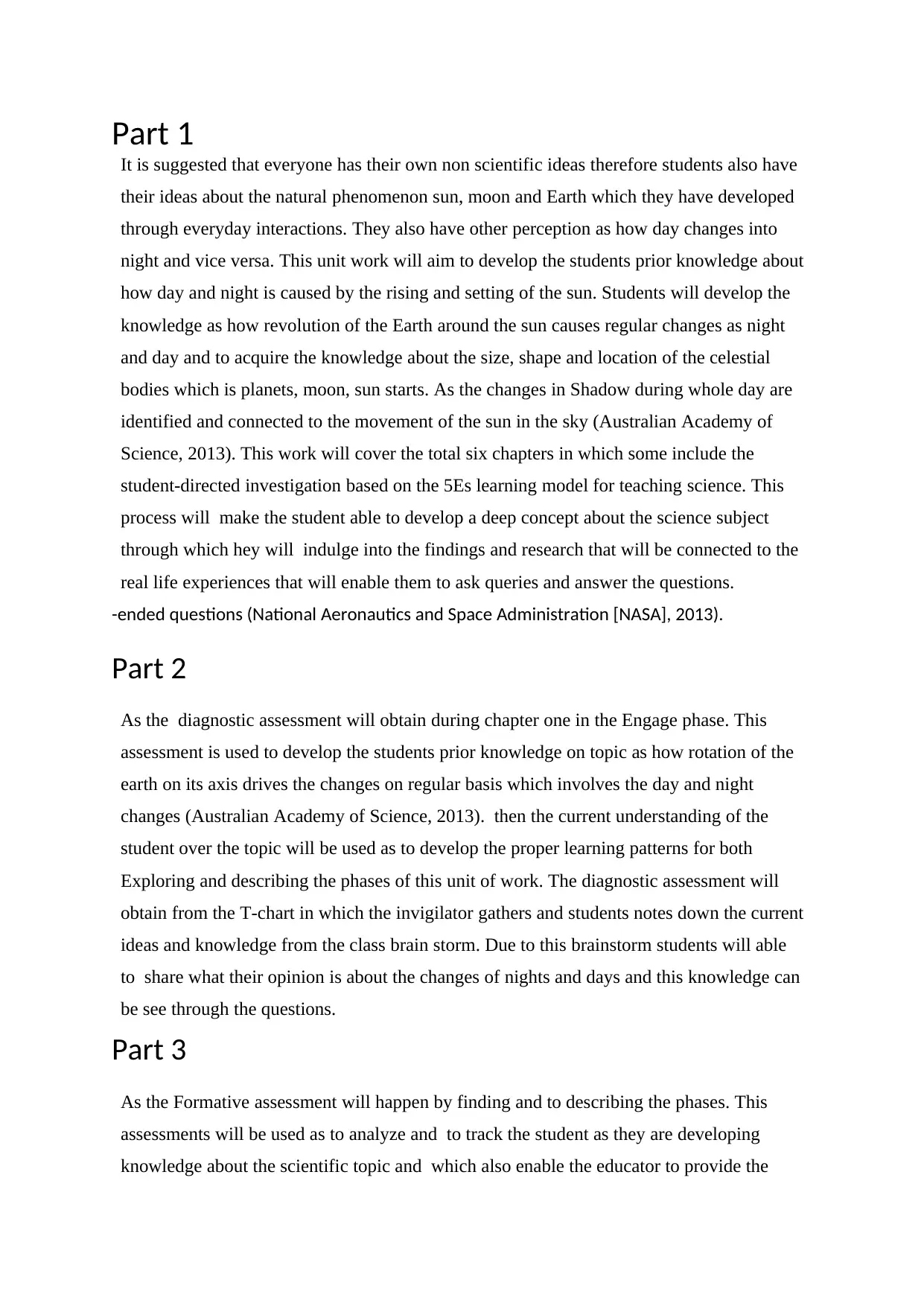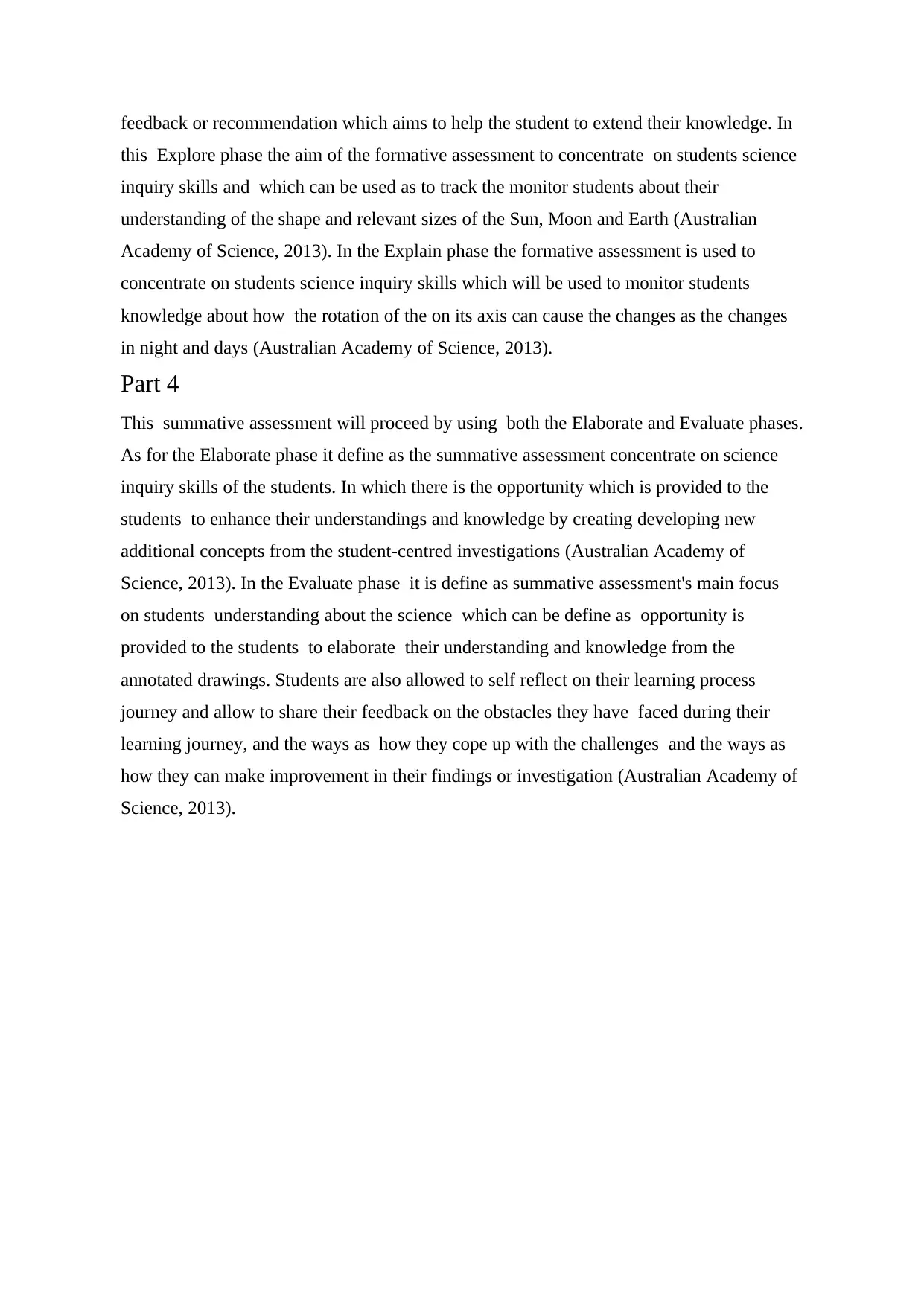Day and Night Cycle: Understanding Earth, Sun, and Moon Dynamics
VerifiedAdded on 2023/06/17
|2
|735
|132
Essay
AI Summary
This essay explores students' understanding of the Earth, Sun, and Moon and their roles in the day and night cycle. It discusses how students' prior knowledge is built upon using the 5Es learning model through six chapters, incorporating student-directed investigations. The essay also details diagnostic, formative, and summative assessment strategies used to gauge student understanding, including T-charts, science inquiry skills monitoring, and student-centered investigations. Emphasis is placed on linking concepts to real-life experiences, fostering inquiry, and allowing students to reflect on their learning journey and challenges.

Part 1
It is suggested that everyone has their own non scientific ideas therefore students also have
their ideas about the natural phenomenon sun, moon and Earth which they have developed
through everyday interactions. They also have other perception as how day changes into
night and vice versa. This unit work will aim to develop the students prior knowledge about
how day and night is caused by the rising and setting of the sun. Students will develop the
knowledge as how revolution of the Earth around the sun causes regular changes as night
and day and to acquire the knowledge about the size, shape and location of the celestial
bodies which is planets, moon, sun starts. As the changes in Shadow during whole day are
identified and connected to the movement of the sun in the sky (Australian Academy of
Science, 2013). This work will cover the total six chapters in which some include the
student-directed investigation based on the 5Es learning model for teaching science. This
process will make the student able to develop a deep concept about the science subject
through which hey will indulge into the findings and research that will be connected to the
real life experiences that will enable them to ask queries and answer the questions.
-ended questions (National Aeronautics and Space Administration [NASA], 2013).
Part 2
As the diagnostic assessment will obtain during chapter one in the Engage phase. This
assessment is used to develop the students prior knowledge on topic as how rotation of the
earth on its axis drives the changes on regular basis which involves the day and night
changes (Australian Academy of Science, 2013). then the current understanding of the
student over the topic will be used as to develop the proper learning patterns for both
Exploring and describing the phases of this unit of work. The diagnostic assessment will
obtain from the T-chart in which the invigilator gathers and students notes down the current
ideas and knowledge from the class brain storm. Due to this brainstorm students will able
to share what their opinion is about the changes of nights and days and this knowledge can
be see through the questions.
Part 3
As the Formative assessment will happen by finding and to describing the phases. This
assessments will be used as to analyze and to track the student as they are developing
knowledge about the scientific topic and which also enable the educator to provide the
It is suggested that everyone has their own non scientific ideas therefore students also have
their ideas about the natural phenomenon sun, moon and Earth which they have developed
through everyday interactions. They also have other perception as how day changes into
night and vice versa. This unit work will aim to develop the students prior knowledge about
how day and night is caused by the rising and setting of the sun. Students will develop the
knowledge as how revolution of the Earth around the sun causes regular changes as night
and day and to acquire the knowledge about the size, shape and location of the celestial
bodies which is planets, moon, sun starts. As the changes in Shadow during whole day are
identified and connected to the movement of the sun in the sky (Australian Academy of
Science, 2013). This work will cover the total six chapters in which some include the
student-directed investigation based on the 5Es learning model for teaching science. This
process will make the student able to develop a deep concept about the science subject
through which hey will indulge into the findings and research that will be connected to the
real life experiences that will enable them to ask queries and answer the questions.
-ended questions (National Aeronautics and Space Administration [NASA], 2013).
Part 2
As the diagnostic assessment will obtain during chapter one in the Engage phase. This
assessment is used to develop the students prior knowledge on topic as how rotation of the
earth on its axis drives the changes on regular basis which involves the day and night
changes (Australian Academy of Science, 2013). then the current understanding of the
student over the topic will be used as to develop the proper learning patterns for both
Exploring and describing the phases of this unit of work. The diagnostic assessment will
obtain from the T-chart in which the invigilator gathers and students notes down the current
ideas and knowledge from the class brain storm. Due to this brainstorm students will able
to share what their opinion is about the changes of nights and days and this knowledge can
be see through the questions.
Part 3
As the Formative assessment will happen by finding and to describing the phases. This
assessments will be used as to analyze and to track the student as they are developing
knowledge about the scientific topic and which also enable the educator to provide the
Paraphrase This Document
Need a fresh take? Get an instant paraphrase of this document with our AI Paraphraser

feedback or recommendation which aims to help the student to extend their knowledge. In
this Explore phase the aim of the formative assessment to concentrate on students science
inquiry skills and which can be used as to track the monitor students about their
understanding of the shape and relevant sizes of the Sun, Moon and Earth (Australian
Academy of Science, 2013). In the Explain phase the formative assessment is used to
concentrate on students science inquiry skills which will be used to monitor students
knowledge about how the rotation of the on its axis can cause the changes as the changes
in night and days (Australian Academy of Science, 2013).
Part 4
This summative assessment will proceed by using both the Elaborate and Evaluate phases.
As for the Elaborate phase it define as the summative assessment concentrate on science
inquiry skills of the students. In which there is the opportunity which is provided to the
students to enhance their understandings and knowledge by creating developing new
additional concepts from the student-centred investigations (Australian Academy of
Science, 2013). In the Evaluate phase it is define as summative assessment's main focus
on students understanding about the science which can be define as opportunity is
provided to the students to elaborate their understanding and knowledge from the
annotated drawings. Students are also allowed to self reflect on their learning process
journey and allow to share their feedback on the obstacles they have faced during their
learning journey, and the ways as how they cope up with the challenges and the ways as
how they can make improvement in their findings or investigation (Australian Academy of
Science, 2013).
this Explore phase the aim of the formative assessment to concentrate on students science
inquiry skills and which can be used as to track the monitor students about their
understanding of the shape and relevant sizes of the Sun, Moon and Earth (Australian
Academy of Science, 2013). In the Explain phase the formative assessment is used to
concentrate on students science inquiry skills which will be used to monitor students
knowledge about how the rotation of the on its axis can cause the changes as the changes
in night and days (Australian Academy of Science, 2013).
Part 4
This summative assessment will proceed by using both the Elaborate and Evaluate phases.
As for the Elaborate phase it define as the summative assessment concentrate on science
inquiry skills of the students. In which there is the opportunity which is provided to the
students to enhance their understandings and knowledge by creating developing new
additional concepts from the student-centred investigations (Australian Academy of
Science, 2013). In the Evaluate phase it is define as summative assessment's main focus
on students understanding about the science which can be define as opportunity is
provided to the students to elaborate their understanding and knowledge from the
annotated drawings. Students are also allowed to self reflect on their learning process
journey and allow to share their feedback on the obstacles they have faced during their
learning journey, and the ways as how they cope up with the challenges and the ways as
how they can make improvement in their findings or investigation (Australian Academy of
Science, 2013).
1 out of 2
Related Documents
Your All-in-One AI-Powered Toolkit for Academic Success.
+13062052269
info@desklib.com
Available 24*7 on WhatsApp / Email
![[object Object]](/_next/static/media/star-bottom.7253800d.svg)
Unlock your academic potential
Copyright © 2020–2025 A2Z Services. All Rights Reserved. Developed and managed by ZUCOL.





